BERLIN, GERMANY
On the train again this time to Berlin, Germany! Berlin is 575 Kilometers from Warsaw and takes 5:40 Minutes. I went to vist my cousin Moshe Nadoff who is working in the The Beit Midrash D’Berlin there website. if you want to know about it in short:
The Beit Midrash D’Berlin is a centre of authentic, intensive Jewish learning and living, located in Berlin, Germany, and serving all of Central Europe. Founded in 2000, our Yeshiva was the first of its kind in the region - a place of Torah learning thoroughly committed to traditional Judaism while totally in tune with today’s world. Our students hail from cities across Germany, as well as Hungary, Poland, Belarus and Moldova. Seminar participants have come from Lithuania, Latvia, the Czech Republic, Serbia and Montenegro, Romania and Bulgaria as well.
Our philosophy is simple - we are committed to the notion that Jewish pursuits, whether personal or political, ought to be rooted in Jewish literacy. We ought to know our own intellectual history, our own modes of thought, our own approach to living. Jews ought to be able to pray in Hebrew, understand the meaning and structure of our prayers. We ought to be able to access our sacred texts, and engage in our thousands of years old tradition of learning. We ought to be able to teach our children, to share our values, to define our priorities, to defend our principles.
To do so, one must learn. And that is what our Yeshiva is about.. Our Yeshiva is supported by many friends around the world. Its founding would not have been possible without the generosity and vision of Mr. Ronald S. Lauder. Today, over half of the operating budget of the Yeshiva is covered with a grant from The Ronald S. Lauder Foundation. The other half of our budget is underwritten by donations, large and small, from around the world. A particularly strong effort in London, England, friends in Zurich, Antwerp, New York and Toronto, and, of course, our Friends Circle in Berlin , all make our programs possible on a daily basis.
 Berlin
Berlin

This is the station I got off at Berlin Ostbahnhof,

now im in middle of Berlin by myself never been here before i know two things i need to get to a street named Rykestrasse 53 and i know i cant take a taxi unless i want to support the Euro and being paying bills for a very long time. i went down staris to the Die Bahn office information to ask them how to get to Rykestrasse. so the guy checked on his computer and told me to the the S3 - Bahn From Berlin Ostbahnhof - Berlin Warschauer Strasse, and there transfer to the M10 Tram and take it from Warschauer Strasse to Prenzlauer Allee/Danziger Strasse, from there walk one block and make a left on Rykestrasse and go straight for 3 blocks, i guess its pretty simple, well i got there!




 The Yeshiva I waited for about 10 minutes till someone answer the door because there is security and you cant just walk in.
The Yeshiva I waited for about 10 minutes till someone answer the door because there is security and you cant just walk in.
when someone finally answer the door he asked me where your coming from and what I want so I said I came to visit my cousin here so he first had no idea who I was talking about and then he said oh you mean Moosha from the USA ahh come in I took it that he was Russian from that. I came in and Moshe was like how did you get here with the tram's and buses etc., so I told him im a big guy I can figure things out on my own. We davened Mincah and sat and spoke for a Half hour and then got directions to the Restaurant. Take the tram to bahan and walk a couple of blocks.
 The Opera house
The Opera house
 Jewish Community Building
Jewish Community Building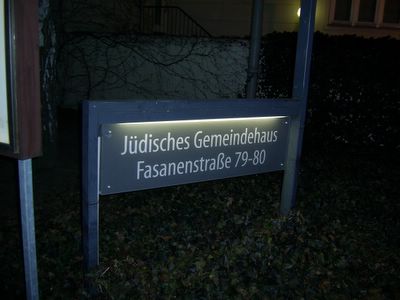
 The Restaurant is in the community building
The Restaurant is in the community building
 We came here at 7:00 p.m
We came here at 7:00 p.mWhen you walk in the building you have to go through security they ask for your passports where you are from why you are here, a very nice welcome no?! well got pass security and went upstairs to the restaurant.



 Me and Moshe
Me and Moshe




we were here till 10:00 P.M. we met a business man here and he offered to take a taxi with us back so we agreed saving us the tram and bus switching procedure.
 Moshe and Nachum Kabalkin
Moshe and Nachum Kabalkin
we sat an spoke for another 1 1/2 till 12 and then went and hit the sack.
 the next morning on my way to the yeshiva this is what i saw
the next morning on my way to the yeshiva this is what i saw

in Berlin there are 4 different garbage's as you can see:
- Residual Waste
- Bio-garbage
- Paper
- Packaging

 The library in Yeshivah
The library in Yeshivah


 A Real Yeshivah
A Real Yeshivah
 Rabbi Shmuel Macner
Rabbi Shmuel Macner





 he gave us directions for The dairy Restaurant and the other places we had to go to.
he gave us directions for The dairy Restaurant and the other places we had to go to.
 shaot zmaniot -
shaot zmaniot -Many observances in Jewish law are performed at specific times during the day. The calculation of these halachic times, known as zmanim (Hebrew for "times"), depends on the various astronomical phenomena of the day for the specific locale. Sunrise, sunset, the amount of time between them, and the sun's angular position before rising are all factors that determine the halachic times and "hours" of the day.The hour has special meaning in Jewish law. When we say that a certain mitzvah may be performed three hours into the day, this doesn’t mean at three in the morning, or three clock hours after sunrise. Rather, an hour in halacha means 1/12th of the day. Thus, if the sun rises at 5 am and sets at 7:30 pm, one sha'ah zemanit, or proportional hour, will be 72.5 minutes, and all calculations will use that number.
the bottom is a SHAOT ZMANIOT CLOCK one of the students built it.
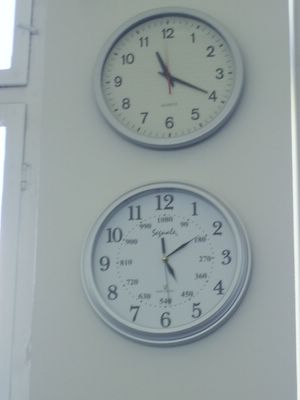
 They have ping pong there also.
They have ping pong there also.
 Right next to they yeshiva there is the Shul that survived the war since it was very close to other building the Germans didn’t want to put on fire so that it wouldn’t burn the building that where close to it..
Right next to they yeshiva there is the Shul that survived the war since it was very close to other building the Germans didn’t want to put on fire so that it wouldn’t burn the building that where close to it..


 Long names for stores
Long names for stores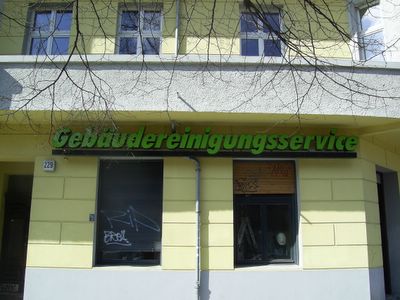
 sign that tells you when the trams and buses are coming very modern.
sign that tells you when the trams and buses are coming very modern.
 The Reichstag
The ReichstagThe Reichstag building in Berlin was constructed to house the Reichstag, the original parliament of the German Empire. It was opened in 1894 and housed the Reichstag until 1933. It again became the seat of the German parliament in 1999 after a reconstruction led by internationally renowned architect Norman Foster.
Today's parliament of Germany is called the Bundestag. The Reichstag as a parliament dates back to the Holy Roman Empire and ceased to act as a true parliament in the years of Nazi Germany (1933-1945). In today's usage, the German term Reichstag refers to the building, while the term Bundestag refers to the institution.
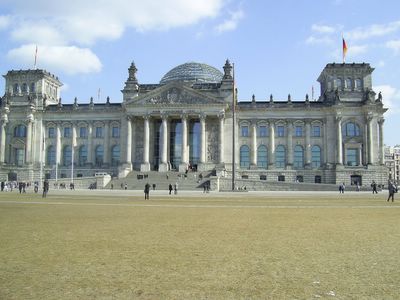


 Brandenburg Gate
Brandenburg Gate
The Brandenburg Gate (German: Brandenburger Tor) is a triumphal arch and the symbol of Berlin, Germany. It is located at 52°30′58.4″N, 13°22′38.7″E on the Pariser Platz and is the only remaining gate of a series through which one used to enter Berlin. One block to its north lies the Reichstag. It constitutes the monumental termination of Unter den Linden, the renowned boulevard of linden trees which led directly to the royal residence. It was commissioned by Friedrich Wilhelm II as a sign of peace and built by Karl Gotthard Langhans from 1788 to 1791.
The Brandenburg Gate consists of twelve Greek Doric columns, six on each side. This allows for five roadways, although originally ordinary citizens were only allowed to use the outer two. Above the gate is the Quadriga, consisting of the goddess of peace, driving a four-horse chariot in triumph. The gate stands 26 m (65 ft) high, (65.5 m) 213 ft wide and (11 m) 36 ft) thick.
The design of the gate was based on the Propylea, the gateway to the Acropolis in Athens, Greece. Berlin had a long history of classicism: first classicist Baroque and then a neo-Palladian, but this was the first Greek revival neo-classical structure in Berlin, which would become the Spreeathen ("Athens on the River Spree') by the 1830s, shaped by the severe neoclassicism of architect Karl Friedrich Schinkel.
While the main design of the Brandenburg Gate has remained the same since it was completed, the gate has played varying roles in Germany's history. First, Napoleon took the Quadriga to Paris in 1806 after conquering Berlin. When it returned to Berlin in 1814, the statue exchanged her olive wreath for the Iron Cross and became the goddess of victory. When the Nazis rose to power, they used the gate to symbolize their power. The only structure left standing in the ruins of Pariser Platz in 1945, apart from the ruined Academy of Fine Arts, the gate was restored by the East Berlin and West Berlin governments. However, in 1961, the gate was closed when the Berlin Wall was built.
In 1963 U.S. President John F. Kennedy visited the Brandenburg Gate. The Soviets hung large banners across it so he could not see the East Berlin side. "The German question will remain open as long as the Brandenburg Gate is closed" was how the Mayor of West Berlin, Richard von Weizsäcker, described the situation in the early 1980s. On June 12, 1987 U.S. President Ronald Reagan delivered a speech to the people of West Berlin at the Brandenburg Gate, yet it was also audible on the East Berlin side of the Wall.
Finally, when the Berlin Wall fell in 1989, the gate symbolized freedom and the unity of the city. It re-opened on 22 December 1989 when the West German Chancellor Helmut Kohl walked through to be greeted by the East German Prime Minister, Hans Modrow.
On July 12, 1994 U.S. President Bill Clinton addressed a speech to the people of Berlin at the Brandenburg Gate talking mainly about peace in post-Cold War Europe.
On December 21, 2000 works began to once again refurbish the Brandenburg Gate, this time using lasers to clean off soot and grit. More than 1,000 pieces of stone were also replaced. Estimated cost: 3,000,000 USD in private funding.
There is some local controversy in Berlin over the fact there is a Starbucks within a few yards of the gate. It is seen as a corporational intrusion upon a national treasure.
The Memorial to the Murdered Jews of Europe, also known as the Holocaust Memorial, is a memorial in Berlin to the Jewish victims of the Holocaust, designed by architect Peter Eisenman. It was opened in 2005 and is located one block south of the Brandenburg Gate. The location of the memorial was the site of the Imperial Chancellery of Adolf Hitler during the Third Empire.
The 19000 square meter (4.7 acre) site is covered with 2711 concrete slabs ("steles"), arranged in a grid pattern on a sloping field. The steles are 2.38m (7.8') long, 0.95m (3' 1.5") wide and vary in height from 0.2m to 4.8m (8" to 15'9"). They are designed to produce an uneasy, confusing atmosphere.
An attached underground "place of information" will hold the names of all known Jewish Holocaust victims, obtained from the Israeli museum Yad Vashem.
The cost of construction was approximately 25 million Euros.





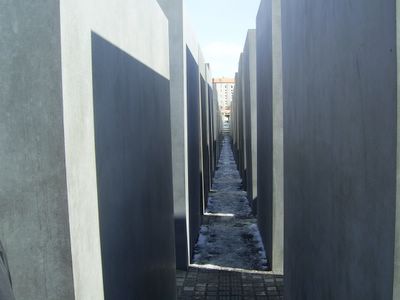
 Sony Center
Sony CenterThe Sony Center is a building complex located at the Potsdamer Platz in Berlin, Germany. The Sony Center was designed by Helmut Jahn and construction was completed in 2000 at a total cost of US$800M. It contains a mix of shops, restaurants, a conference center, hotel rooms, luxurious rented suites and condominiums, offices, art and film museums, movie theaters, and an IMAX theater. Free Wi-Fi connections are available for all visitors.
The corporate sponsor of the Sony Center is (understandably) Sony.







 Bahnhof Potsdamer Platz
Bahnhof Potsdamer Platz
Berlin's Potsdamer Bahnhof was located at Potsdamer Platz, about 800m south of the Brandenburg Gate, and it was this that kick-started the transformation of Potsdamer Platz from an area of quiet villas near the south-east corner of the Tiergarten into the teeming focal point that it eventually became. Berlin’s first railway, linking it with Potsdam and begun in 1835, it was opened from Potsdam as far as Zehlendorf on 22nd September 1838, and the entire 26km on 29th October. The first train was hauled by a British-built locomotive, the work of Robert Stephenson no less, at his Newcastle-upon-Tyne works, in 1835, and called “Adler” (Eagle). That same year, on 7th December, it hauled the first train to run anywhere in the future Germany, on the short (7km) Nuremberg to Furth Railway. But three years later, on 22nd September 1838, it hauled the first train to operate in Prussia, between Potsdam and Zehlendorf, and would take it all the way into the Berlin terminus on 29th October. The whole area around the terminus became a major focus for urban growth from this time on. Five major streets would eventually converge there, most having started out as mere dirt-tracks through the Tiergarten and adjoining fields.
The first Potsdamer Bahnhof lasted until 1869, by which time it could not cope with growing traffic, so it was superseded by a far grander structure built by Julius Ludwig Quassowski (1824-1909), with five platforms, a train-shed roof 173m long by 36m wide, and a separate entrance on the west side for royalty. Opened on 30th August 1872, by 1890 over 3 million people a year were using it, and it was holding its own against a much larger rival down the road (the Anhalter Bahnhof).
Still the facilities could not cope, and so in 1890-91 two extra termini were built either side of it for short-haul and suburban traffic: on the east side, the Ringbahnhof, opened 1st April 1891 to serve the Ringbahn itself, the circular route skirting the city’s perimeter with connections to all the main termini; and the Wannsee Bahnhof on the west side, opened 1st October 1891 for trains to Wannsee and the south western suburbs. Steam-operated at first, the Ringbahnhof lines were electrified (550v DC), 4th June 1903 (converted to 800v DC on 2nd July 1929), but the lines from the Wannsee Bahnhof, and also the main-line terminus (alternatively known as the “Fernbahnhof,” meaning Long-Distance Station, to distinguish it from the others), had to wait until 15th May 1933. The Ringbahnhof ultimately handled many times as many passengers as the Main-Line Terminus. The Ringbahn itself had originally opened in two stages: the eastern section for goods on 17th July 1871 and passengers on 1st January 1872; and the western section for all traffic on 15th November 1877. Although smaller than the Anhalter, the Potsdamer Bahnhof became much the busier of the two. By 1939 up to 80,000 people per DAY were using it. The Wannsee Bahnhof actually closed that year, superseded by the new S-Bahn north-south link between Unter den Linden and Yorckstrasse (via Potsdamer Platz and Anhalter Bahnhof), opened in stages during the year.
During World War 2 the terminus, like most of Berlin, was devastated by British and American bombs and Soviet artillery shells. The air raid that sealed the station's fate was that on the night of 23rd/24th November 1943, when the station lost its roof and the whole area around Potsdamer Platz was pulverised, but despite some rubble clearance and emergency repairs, damage to the rail infrastructure further out was so great that the Main-Line Terminus never saw another train, its formal closure and that of the Ringbahnhof occurring on 3rd August 1944. The Ringbahnhof got a reprieve of sorts, though, temporarily reopening on 6th August 1945 while the U and S-Bahn received massive repairs (millions of gallons of water needed to be pumped out for starters), before final closure on 27th July 1946. After lingering on for 11 more years, the remains were cleared away in 1957. The Anhalter Bahnhof and all of Berlin’s other rail termini suffered a similar fate, (exacerbated in some instances by the Division of Berlin and the building of the Wall in 1961), leaving a network that remained fragmented and inconvenient for decades.
Today a number of vast and spectacular new developments can be seen around Potsdamer Platz. Although perhaps not to everyone's taste architecturally, the new quarter is certainly a commercial success, and a must-see for the majority of visitors to Berlin. But where the Potsdamer Bahnhof once stood is a long landscaped strip of land named after the great Austrian actress Tilla Durieux (1880-1971), stretching for 450m down to the Landwehrkanal.
 "Funny Looking Building" that's the name of it.
"Funny Looking Building" that's the name of it.
 U-Bahn the underground system
U-Bahn the underground system
 KaDeWe
KaDeWe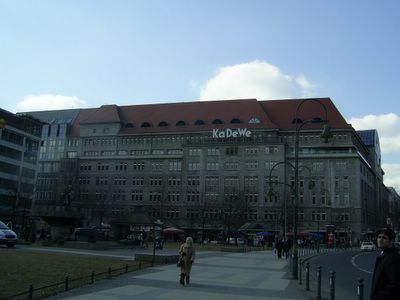
Kaufhaus des Westens (commonly abbreviated KaDeWe) is a very large department store in the city of Berlin. It claims to be the largest such store in all of continental Europe, with over 60,000 square meters of floor space. The store was originally built in 1907, and then destroyed in World War II. It was re-opened in 1950. The 6th and 7th floor (added in the early 1990´s) are entirely devoted to food. The 6th Floor delicatessen is famed for its wide variety of food and drink. KaDeWe was part of the Hertie corporation until this corporation was acquired by KarstadtQuelle AG.








 he saw us taking a picture so i he asked for money its weird no officially he cant move or talk?
he saw us taking a picture so i he asked for money its weird no officially he cant move or talk?
 The Dairy Restaurant where we ate lunch!
The Dairy Restaurant where we ate lunch!






 Zecher Lechurban
Zecher Lechurban



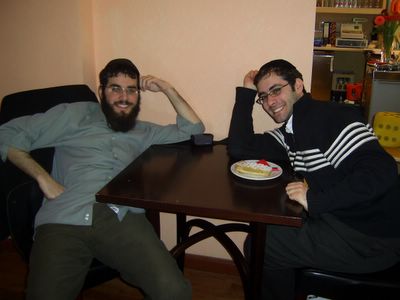
 Chabad of Berlin
Chabad of Berlin




 Dunkin Doughnuts
Dunkin Doughnuts
 Berlin Zoologischer Garten
Berlin Zoologischer Garten
 inside terminal not like the Poland train station very nice and well put togather.
inside terminal not like the Poland train station very nice and well put togather.
 Berlin Zoologischer Garten
Berlin Zoologischer Garten
the train left at 4:37 arrived back in Warsaw at 10:25!


Legend has it that Marco Polo introduced to Italy some products from China, including ice cream, the piñata and pasta, especially spaghetti. However, these legends are highly dubious — for instance, there is evidence that pasta was known in Italy since antiquity.
well that's berlin for a couple of hours.


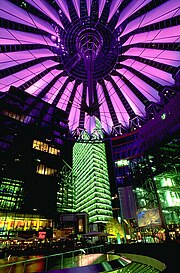

2 Comments:
hi meir
please email me a.s.a.p.
uria.ohana@gmail.com
i have something to talk to you
thanks
uria
NOOOOOOOO??? SHLUFEN?
OSTE A SHTIKEL NAYES?
Post a Comment
<< Home